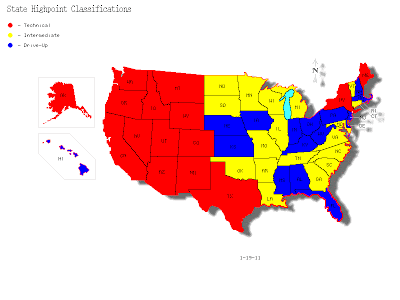- by Bill Urbanski
Five AM, and it’s five below (F). I’m standing in a small clearing in the middle of the woods.
“Boom!”
“Pop! Crackle! Bang!”
Reverberations echo in my ears and the 10,000 or so faces shivering alongside me are instantly lit by fireworks exploding above our heads. Rock music blares from surrounding speakers. The crowd cheers and bounces to the rhythm, in just as much an effort to keep warm as to enjoy the music and the moment.
At one end of the clearing a makeshift stage has been erected, in the middle of which is a large tree stump with a door. As a backdrop, a ten by twelve foot painted plywood sign announces to all in attendance: “Weather Capital of the World.”
On any other day of the year, this clearing would likely be, well clear. But today is no ordinary day. It’s February 2nd – Groundhog’s Day, and today I’m standing at Gobbler’s Knob in Punxsutawney, Pennsylvania.
I was living in Columbus, Ohio at the time, and for years had considered making a trip to the sleepy little hamlet in western Pennsylvania to observe and to take part in the festivities surrounding this most curious of American holidays.
My girlfriend Cheryl, who was just as mischievous and spontaneous and, well as crazy as I was, did not hesitate when I proposed that we drive four hours to see a rodent pop out from under a rock.
“Let’s go. Sounds like fun,” was her immediate response.
We left Columbus on the evening of the 1st and drove to Brookville, the closest town to Punxsutawney where we could find a hotel. We got in well after midnight, and managed just a few hours of sleep before it was time to push on the final twenty miles to Punxsutawney.
Gobbler’s Knob is actually on the outskirts of town, not in the town square, as depicted in the Bill Murray movie Groundhog Day. And on February 2nd, the only way to get to the Knob is on foot or by shuttle bus.
The local public schools are closed for the day and school buses are used to shuttle revelers the mile and a half from a mall parking lot to the Knob. The road is otherwise closed to traffic.
Cheryl and I disembarked our shuttle at 4:30 AM and found ourselves in the middle of a huge outdoor party. Thousands roamed the vicinity. Satellite trucks ringed the Knob. Floodlights lit the nearby barren trees which served as backdrops for live news shots. Reporters were on hand from local stations and major networks and of course, The Weather Channel.
 |
| Bill Murray reporting live in Groundhog Day |
We mingled with the mostly college-aged set, and searched for a good vantage point from which to view the stage. A bonfire kept those warm who were lucky enough to be near. All others were forced to rely on their own heavy coats, blankets or the huddled warmth of a close friend.
As the appointed hour drew near, the temperatures climbed slightly, and the dawn began to break.
Then, just when we thought the scene could not be more surreal, a small army of men clad in top hats and tuxedos emerged from the woods and took to the stage. These men are “The Inner Circle,” a group of fifteen or so dedicated followers of Punxsutawney Phil.
The tradition at Gobbler’s Knob dates back to the late Nineteenth Century. In fact, 2011 marks the 125th celebration. The date itself coincides with Candlemas Day, an old European celebration roughly marking the mid-way point between the Winter Solstice and the Vernal Equinox. Tradition told that a sunny Candlemas Day meant a longer winter. Hence, when Phil sees his shadow, six more weeks of winter is forecast.
Seven twenty-four AM. Phil’s handler knocks on the door to the stump using a silver-tipped cane. No answer, so he knocks again.
“We want Phil. We want Phil…” the boisterous crowd is now chanting in unison.
Phil’s keeper opens the door, reaches inside the stump and pulls out the plump, furry creature, holding him aloft to the rapturous approval of the masses.
 |
| Phil and his handler greet the crowd |
Phil is placed on top of the stump and the Inner Circle crowds around. Those who are fluent in Groundhogese are closest. Murmurs are heard in the crowd as Phil makes his pronouncement to his handlers.
And then, with the requisite ceremony and solemnity attendant an Habemus Papam announcement, the proclamation is read aloud. Phil, we are told, has seen his shadow – six more weeks of winter. The crowd groans and laughs its disappointment.
Three hours of standing in near zero temperatures is wearing thin Cheryl’s normal cheerful spirit. It takes a little convincing but she agrees to stand with me at the end of the line of people waiting their turn to pet the rat, and to get a personalized photograph.
 |
| Phil, his handler, and Bill |
Shortly after eight, I take the stage grinning for posterity. Cheryl snaps the shutter, and we race for our yellow shuttle. A hot cup of tea and a hearty breakfast in a heated restaurant await us down below. With bodies warmed and spirits renewed, we climb back into our car and leave Punxsutawney behind.
Happy Groundhog’s Day!








































